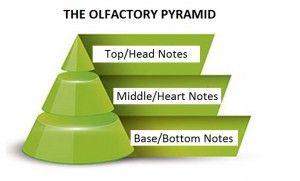The perfume has a structure in three stages. The first one includes the top/head notes that we perceive at the first moment with the aim of impacting whoever smells them. It starts being perceived 30 seconds after applying the fragrance and it does not last more than 15 minutes.
The second stage corresponds to the middle/heart notes which contain the main ingredients of the fragrance and determine the real spirit of the perfume. Its aroma can last for 4 hours. Finally, we find the base/bottom notes which fix the perfume and make the fragrance smell for hours or days. Its function is to fix the components of the other notes.
Aromas are little volatile molecules which are dissolved in water and oil. Aromas float in the air and reach our nose, and that’s when we can detect them. We live submerged in a world of invisibles aromas.
Aromas suspended in the air are dissolved in the nasal mucosa and transported to the receiving cells located in the olfactory bulb. In this bulb there are specific recipients for aromas that generate an electric signal sent to the olfactory nerve when interacting. This signal gets to the limbic system in charge of processing and managing the responses. Once the information in the limbic system is processed, it is stored in the cerebral cortex. It is considered that 75% of our emotions are related to aromas.
This is one of the reasons why the members of the European Association of Perfume and Cosmetic Products (APCE) have returned to traditional packaging and manufacturing practices and have given more power of decision to consumers prioritizing the sense of smell and touch over brands, advertising and packaging. The APCE members have been able to adjust their companies to meet the requests of 21st century consumers who place ever greater demands on high product quality, transparency and a greater power of decision, as they are not appealed solely by the advertising patterns of the 20th century any more.


